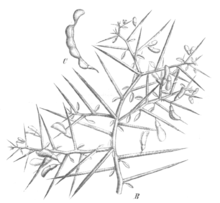Alhagi
| Alhagi | |
|---|---|

| |
| Alhagi maurorum | |
| Scientific classification | |
| Kingdom: | Plantae
|
| (unranked): | Angiosperms
|
| (unranked): | |
| (unranked): | |
| Order: | |
| Family: | |
| Subfamily: | |
| Tribe: | Hedysareae
|
| Genus: | Alhagi , 1755
|
| Type species | |
| Alhagi maurorum Medik.
| |
| Species | |




Alhagi is a genus of Old World plants in the family Fabaceae. They are commonly called camelthorns or manna trees. There are three to five species.
Alhagi species have proportionally the deepest root system of any plants - a 1 m high shrub may have a main root more than 15 m long; due to their deep root system Alhagi species are drought-avoiding plants that utilize ground water, adapting in that way perfectly to the hyper-arid environment.
Alhagi species are used as food plants by the larvae of some Lepidoptera species including Coleophora argyrella which feeds exclusively on A. maurorum.
The genus name comes from the Arabic word for pilgrim.
Benefits in Unani Medicine[]
Alhagi in Persian is "KhareShotor" which means thistle of camels, as camels can eat it with its thorns. As such, it was figured out that the plant can retain the abdominal organs in severe thirst. In the Middle East, its boiled or distillated juice is used against kidney and bladder stones. Also, the plant foliage is the habitat of a special insect which produces Manna of hedysarum or Tarangabeen, which is a honey remedy for neonatal jaundice.[1]
References[]
- ^ "Alhagi persarum" (PDF). Cite journal requires
|journal=(help)
External links[]
| Wikispecies has information related to Alhagi. |
| Wikimedia Commons has media related to Alhagi. |
- Jepson Manual Treatment
- Alhagi maurorum Medik
- Water relation characteristics of Alhagi sparsifolia and consequences for a sustainable management [1]
- Hedysareae
- Fabaceae genera
- Faboideae stubs